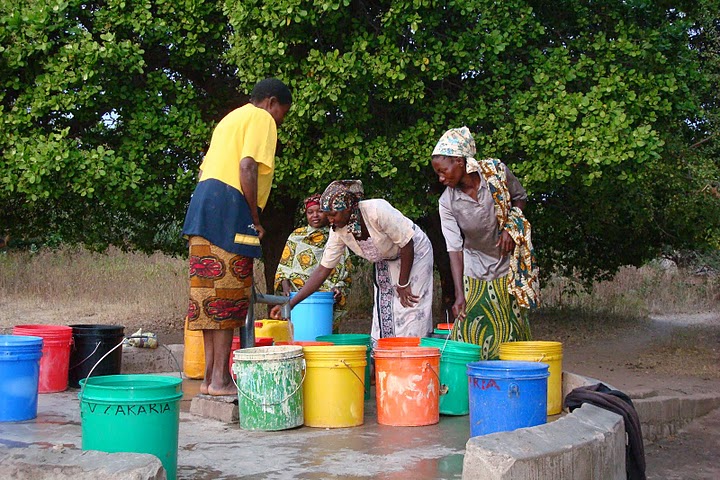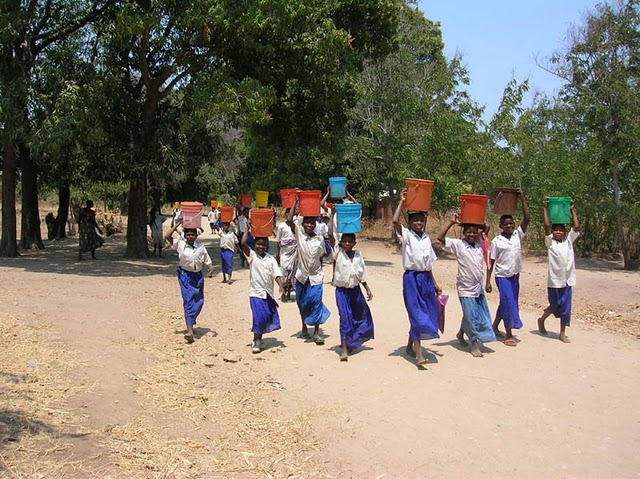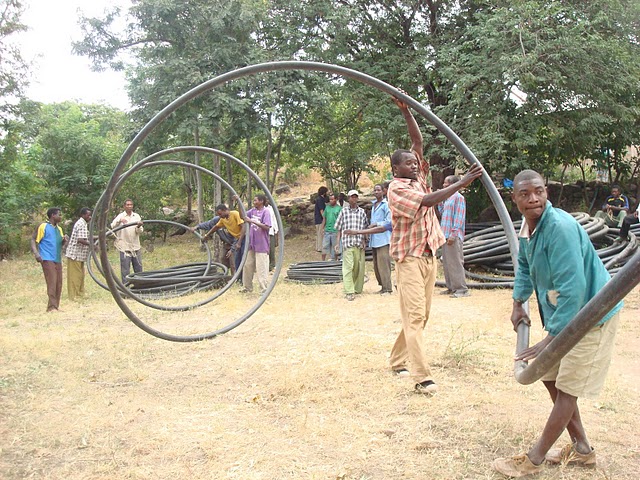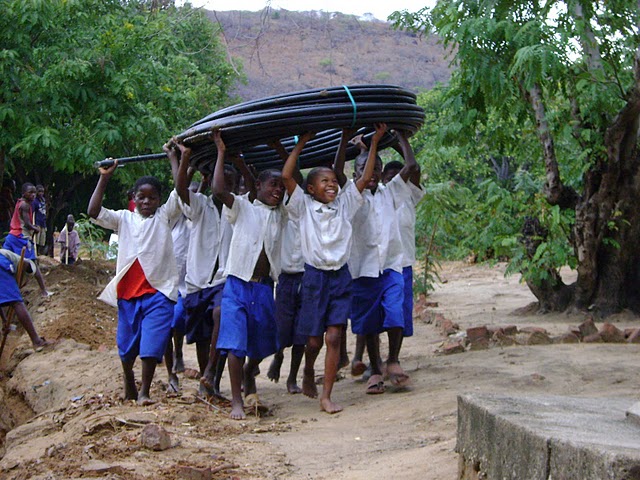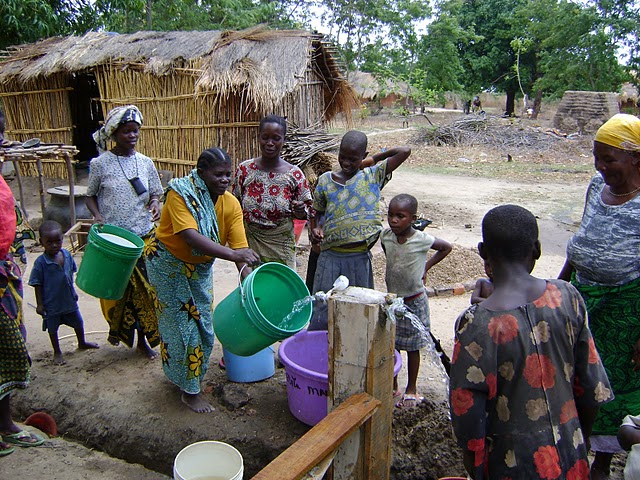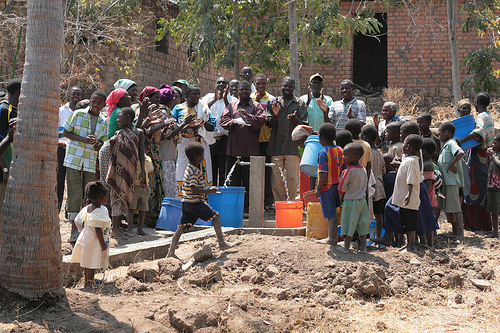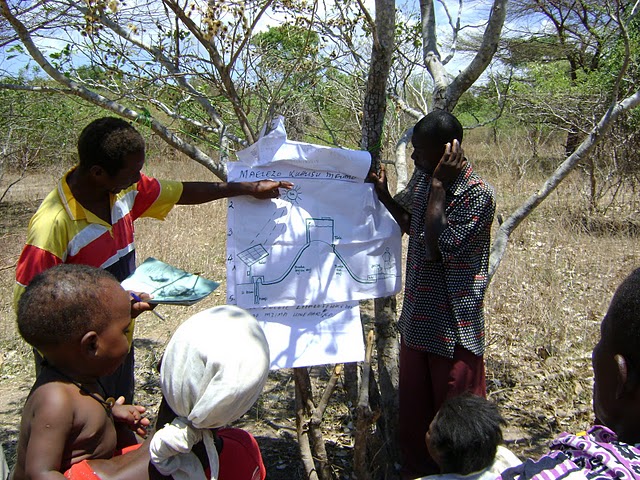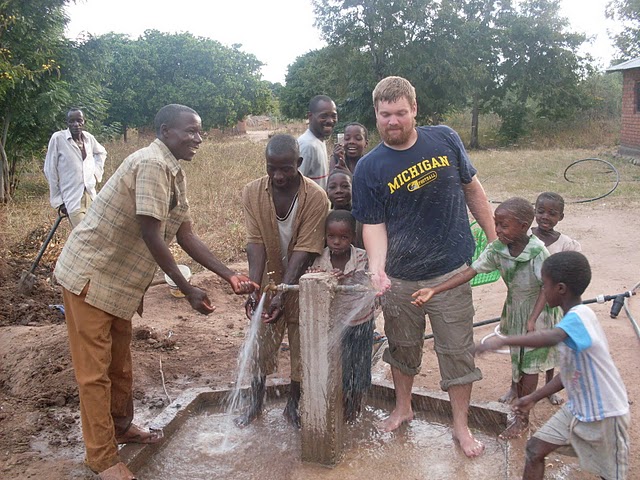Ngelenge, Tanzania
From 2006 to the present, Engineers Without Borders-USA San Francisco Professional Chapter (EWB-SFP) volunteers have worked with the community of Ngelenge, Tanzania and the village based Ngelenge Development Association (NGEDEA) to build a water distribution system that greatly improves access to water for the community of over 2,000 residents. The system consists of a 50m well, a 15,000 gallon tank, a solar powered pump, and almost 4 miles of piping. It delivers water to 18 access points in the community so that no family has to walk further than 100 yards to retrieve water. Working with the community to build the system has been an amazing journey…
Unfortunately, in 2010 the Ngelenge water system ran into an issue where a large amount of sand infiltrated the well. After several attempts to clean the well and the pump, it shut down the system completely. This was a major disappointment for everyone involved in the project from villagers to volunteers to donors.
In order to make the system robust so that the village can maintain it over the long term, this summer we drilled a new well with a new design implemented to deal with the difficult sand conditions.
YOUR SUPPORT MADE POSSIBLE THIS SYSTEM REHABILITATION.
We are now continuing with training and capacity development of the local water managing team, together with our monitoring of the system performance.
PLEASE CONTINUE TO SUPPORT THE PROJECT TO HELP ENSURE THAT THE SYSTEM YOU HELPED BUILD CAN BE SUSTAINED BY THE PEOPLE OF NGELENGE FOR FUTURE GENERATIONS
Ngelenge, Tanzania
Project Background
The tranquil rural village of Ngelenge, Tanzania is located in Southwest Tanzania on a wedge of land on the shores of Lake Nyasa and the Ruhuhu River. The village consists of over 2000 people living in mud brick homes and subsisting on fishing and the products from their agriculture and livestock. Their annual disposable income is around $200.
In 2004 EWB-SFP was contacted by Ngelenge Development Association (NGEDEA), a local NGO. EWB-SFP responded with a commitment to a project that would fund and implement a medical dispensary, a supply of healthy water and training in proper hygiene for Ngelenge. At the time, villagers lacked local health care, hygienic conditions, and access to clean water.
The Need
Many people in Ngelenge suffered each year from malaria and dysentery. The people of this village are motivated to correct these conditions, but were unable to for lack of funds, training, and technology. They had to walk to neighboring villages to reach a health dispensary and two of the three wells that existed prior to 2004 were easily contaminated and were a several kilometers walk from many homes. During the initial site assessment and first implementation trip (2005-2006), EWB-SFP volunteers accomplished several preliminary planning and engineering activities. An economic assessment of the community and development priorities was established with participatory workshops and community water requirements and health needs were determined through health and water use surveys and water quality testing. The main priorities identified by the villagers and NGEDEA during this time were:
- Need of a health dispensary for basic primary care and access to medcine
- Improvement of access to clean water
- Economic development, primarily through agriculture
EWB-SFP Response
The Ngelenge Health Dispensary
During the 2005 site assessment trip, the EWB-SFP team also provided some funding for the health dispensary building for which the foundation had already been constructed by the village. Two more injections of funds over the next two years, in addition to a grant secured by NGEDEA directly from the Tanzanian Government, were required to complete construction of the dispensary. The district government allocated funds to provide furniture, medicine and personnel in 2009 and at the end of summer 2009 the dispensary was open to the public.
The Water Project
In order to improve the community's access to water it was determined that a solar-powered pump feeding a distribution system would be required. To start this effort, three wells were drilled in 2006, one of which was identified as suitable for installation of a powered pump. The other two wells were outfitted with hand pumps. During the 2006 trip, a water distribution survey was performed to identify appropriate locations for a storage tank, water lines, and a distribution system comprised of 17 tapstands distributed in the four sub-villages of Kivukoni, CCM, Maguland and Shuleni – each tapstand serving between 10 and 20 households. A fund generation plan was initiated with the goal of the community raising a percentage of the capital cost of the distribution system project.
System Installation
During the 2008 implementation trip, EWB-SFP facilitated meetings of an interim water committee board. This board wrote a Water Constitution that clearly stated the roles and responsibilities of the future bodies that would manage the system.. The Water Constitution was read during a village meeting and approved by the community at large.
In addition, during summer 2008, EWB-SFP and the village completed the construction of a 15,000 gallon tank for the water distribution system
The first priority for the 2009 implementation was capacity development, with no strict goals on construction schedule/progress. EWB-SFP traveled to Ngelenge with the primary goal of helping the village institutions get to a place where they were ready to manage construction and maintenance of the water distribution system. We were unsure how long this would take, but it turned out that the village was much more prepared than expected. Tapstand committees had been selected for all 17 tapstands following proper procedure as stated in the Water Constitution signed the previous year. The Executive Water Committee was formed on the 3rd day after the EWB-SFP volunteers’ arrival and once that group was given responsibility for management, they ran with it. The community capital contribution was collected in short order and the Executive Water Committee set in a path to try to complete the project before the end of 2009. EWB-SFP responded to this plan and placed an order for the solar power pumping system.
Work commenced on construction in parallel with many training sessions regarding system operation and maintenance. The EWC was trained on their responsibilities and they worked with EWB-SFP volunteers to generate a budget and maintenance plan for the system. A system use training seminar was developed, and the Water Committee began training tapstand committees and water users. A technical training was also given to teach the system technicians to do water quality testing and perform system maintenance. Every day, community volunteers were digging trenches and helping to lay distribution piping while the local masons were constructing the tapstands as well as a guard house and security fence for protection of the wellhead and solar panels. A contractor from Dar Es Salaam was hired to install the solar panels and pump. The tank was cleaned and the full water system was disinfected twice to remove contamination.
In November of 2009, an inauguration ceremony was held and 6 months of hard work paid off as the first water came out of the taps and was enjoyed by everyone.
During the winter of 2010 we began receiving reports from the village of problems with the pump. The village technicians serviced the pump several times with the assistance of the pump vendor. By the beginning of the summer it became clear that the problem was due to the high level of sand in the well.
EWB-SFP devised a set of troubleshooting procedures to rehabilitate the well. During the 2010 summer implementation trip, a well cleanup procedure was attempted, and sediment samples where brought back to the US for analysis and to provide our technical team with information needed to design improved screens for the deeper portion of the well. The system was functioning during the summer, but by the end of the October the system had shut down completely due to sand infiltration and failure of the pump.
2011 System Rehabilitation
In the summer of 2011, a team traveled to Ngelenge to drill a new well and install a new pump for the village. The new well was designed by a team of experts in the US and drilled by the an in-country contractor with oversight provided by an EWB Volunteer Hydrogeologist. Once the new well was drilled, installed, and developed properly, the new pump was placed in the well and the system restored to operation. YOUR SUPPORT MADE THIS POSSIBLE.
Moving Forward
The water distribution system is a significant technological advance for the village of Ngelenge. It is the first public utility in the community and requires a level of civic engagement and management than the village has not experienced before. Change comes slowly and it will take time and hard work for the village to adapt and succeed at this new level. We know they have the capacity to do so and are ready to stick by their side and be patient as they fail, learn, and try again. EWB-SFP is committed to helping with capacity development and trainings to help them succeed, and we will continue to monitor and evaluate the village water quality, hygiene, management and operations of the system through site visits and other regular communications.
Your donation will go directly toward the monitoring and trainings described above.. Any amount you can donate, large or small will help ensure that the water keeps flowing in the village.

